Week 6. Talk of being halfway through the course has been and gone, to be replaced with talk of exams…despite them still being 4 weeks away. Whilst exam fear slowly sets in, the cooking continues…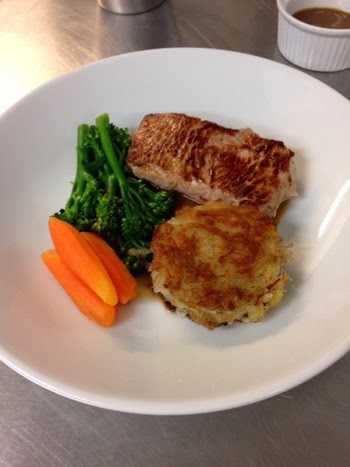 I feel like every week I say have a new nemesis in the kitchen but this week I really did: turning vegetables. Taking a round carrot, making it square, then making it an even 7 sided barrel. I’ve never been a patient person and this definitely tested me as my slightly lopsided carrots above show! Thankfully learning potato rosti saved the day – anything cooked in that much butter has to be good!
I feel like every week I say have a new nemesis in the kitchen but this week I really did: turning vegetables. Taking a round carrot, making it square, then making it an even 7 sided barrel. I’ve never been a patient person and this definitely tested me as my slightly lopsided carrots above show! Thankfully learning potato rosti saved the day – anything cooked in that much butter has to be good!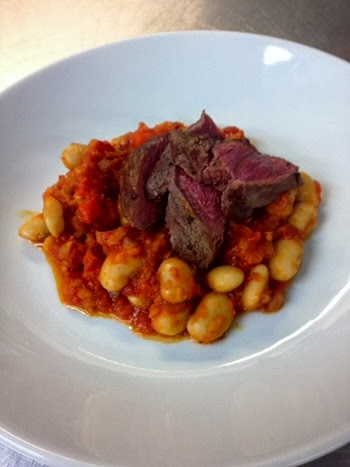 This week’s main challenge was tunnel boning a leg and shoulder of lamb. Essentially this involves getting a bone and joint out of the piece of meat in one piece without opening up the meat – picture digging the Channel Tunnel, our teacher said. It’s always nerve-wracking if even the teachers admit it is hard and so it was a very welcome surprise when it actually turned out to be satisfying! Half an hour of innuendo and butchery later and it was much more enjoyable than jointing a chicken ever was. We used cuts from the shoulder to create our own dish, hence the lamb on spicy tomato and butterbean stew above. Five months ago I wouldn’t have imagined myself saying things like ‘perhaps a basil oil would have brightened up the plate’ but it appears I do now!
This week’s main challenge was tunnel boning a leg and shoulder of lamb. Essentially this involves getting a bone and joint out of the piece of meat in one piece without opening up the meat – picture digging the Channel Tunnel, our teacher said. It’s always nerve-wracking if even the teachers admit it is hard and so it was a very welcome surprise when it actually turned out to be satisfying! Half an hour of innuendo and butchery later and it was much more enjoyable than jointing a chicken ever was. We used cuts from the shoulder to create our own dish, hence the lamb on spicy tomato and butterbean stew above. Five months ago I wouldn’t have imagined myself saying things like ‘perhaps a basil oil would have brightened up the plate’ but it appears I do now! 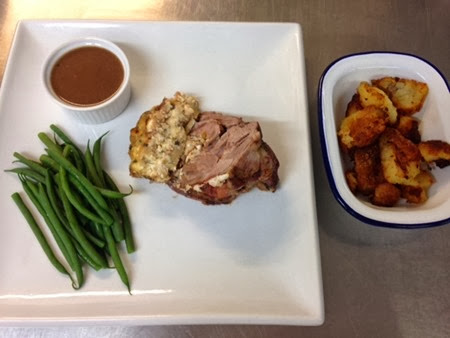 By a Friday afternoon sometimes you’re not quite thinking straight…which may be how my fab roast partner Rosie ended up dipping green beans in citrus sugar syrup instead of gravy and I have a brand new burn on my wrist, to replace the burn that had just faded in exactly the same place. Nevertheless we managed to get our truffle pasta, stuffed lamb roast dinner and citrus cake all served so we could focus on the bigger issue: how to take a cake, half a roast, a whole raw shoulder of lamb, pasta dough and a weeks worth of chefs whites home on the bus. Bring on week 7…
By a Friday afternoon sometimes you’re not quite thinking straight…which may be how my fab roast partner Rosie ended up dipping green beans in citrus sugar syrup instead of gravy and I have a brand new burn on my wrist, to replace the burn that had just faded in exactly the same place. Nevertheless we managed to get our truffle pasta, stuffed lamb roast dinner and citrus cake all served so we could focus on the bigger issue: how to take a cake, half a roast, a whole raw shoulder of lamb, pasta dough and a weeks worth of chefs whites home on the bus. Bring on week 7… 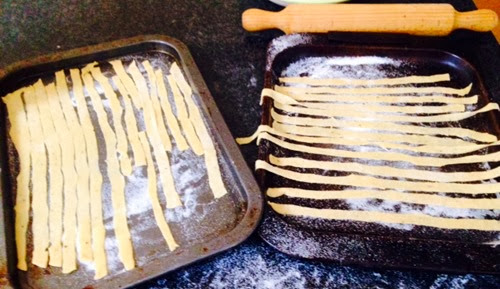
Tuesday 25 February 2014
Leiths Intermediate Term, Week 6
Sunday 23 February 2014
Toscakaka (Caramel Almond Cake)
This cake is perfect for an almond fan like me. Can’t find a way to get them into the actual sponge? No biggie, just chuck a thick caramel drenched layer of them on top instead. Problem solved. 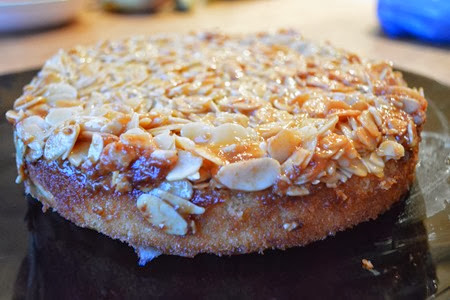 The name alone tempted me to this cake – both the Scandinavian version (Toscakaka is too much fun to say) and the English translation. Caramel, almond and cake are 3 great words on their own but put them all together in one recipe and I knew I was in for a treat. I was proved right whilst making the butterscotch sauce to coat the almonds, when I had to be highly restrained because ohmygoodness it smelt and tasted incredible! The end result is quite a dense cake, almost Madeira-like in texture, with a thick crunchy and sweet layer of almonds packed on top. Surprisingly, considering the amount of butterscotch involved, this cake is not very rich and worryingly easy to have more than just the one slice. You can find the recipe here – I didn’t make any changes except from not including any vanilla or coffee in the topping because, well… I forgot. Enjoy!
The name alone tempted me to this cake – both the Scandinavian version (Toscakaka is too much fun to say) and the English translation. Caramel, almond and cake are 3 great words on their own but put them all together in one recipe and I knew I was in for a treat. I was proved right whilst making the butterscotch sauce to coat the almonds, when I had to be highly restrained because ohmygoodness it smelt and tasted incredible! The end result is quite a dense cake, almost Madeira-like in texture, with a thick crunchy and sweet layer of almonds packed on top. Surprisingly, considering the amount of butterscotch involved, this cake is not very rich and worryingly easy to have more than just the one slice. You can find the recipe here – I didn’t make any changes except from not including any vanilla or coffee in the topping because, well… I forgot. Enjoy!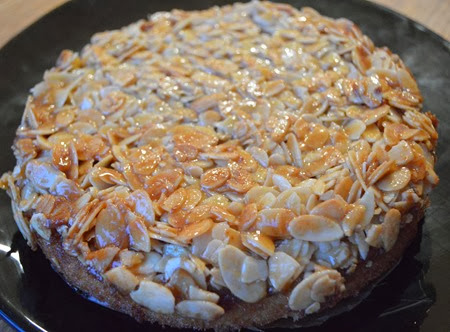
Saturday 22 February 2014
Leiths: Intermediate Term, Week 5
Week 5 of 10 this term – no more avoiding the fact that I am definitely half way through the course now. Where does time go? I’m beginning to wish this was a two year course. Here’s how week 5 went…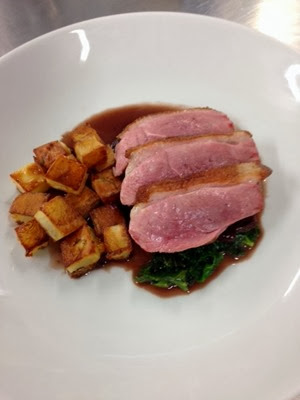 This was the first week that we got to be creative – choosing our own accompaniments to the duck and cherry sauce dish from a list of ingredients. I’ve got so used to following strict recipes and curriculums to the letter that it felt quite strange to have a bit more free reign this time. As it was our first time I kept it simple doing braised spinach and little garlic roasted potatoes. The potatoes tasted good but as my teacher pointed out ‘if you’re going to do potato cubes, you need to do potato cubes’…more knife skill practice needed!
This was the first week that we got to be creative – choosing our own accompaniments to the duck and cherry sauce dish from a list of ingredients. I’ve got so used to following strict recipes and curriculums to the letter that it felt quite strange to have a bit more free reign this time. As it was our first time I kept it simple doing braised spinach and little garlic roasted potatoes. The potatoes tasted good but as my teacher pointed out ‘if you’re going to do potato cubes, you need to do potato cubes’…more knife skill practice needed! 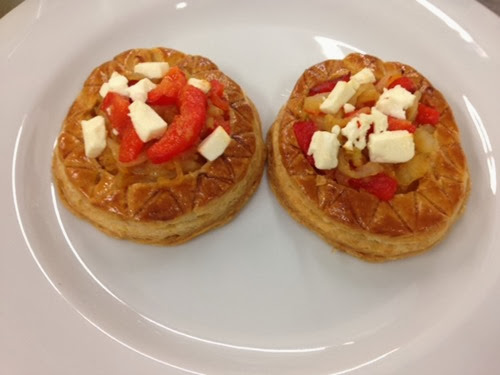 This week saw the return of flaky pastry! And another chance to be creative as we chose our own tart toppings. There’s something even more intimidating when presenting your own dish as it’s an extra aspect to be judged on but I was quite pleased with how these dinky onion, red pepper and feta tarts turned out, again a relief after spending two days making the pastry base!
This week saw the return of flaky pastry! And another chance to be creative as we chose our own tart toppings. There’s something even more intimidating when presenting your own dish as it’s an extra aspect to be judged on but I was quite pleased with how these dinky onion, red pepper and feta tarts turned out, again a relief after spending two days making the pastry base!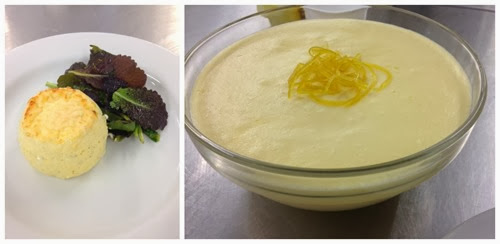 Week 6 could also be known as soufflé week, with 3 soufflés in the kitchen sessions and a whole soufflé demonstration. Soufflés are one of those dishes that seem to have a circle of fear around them, regarded as being notoriously tricky and temperamental. That’s one of the aspects I love most about Leiths – they take dishes that I’ve always avoided trying and break them down to seem much less scary and ensure that I understand exactly why they can be so finicky to make. 3 different soufflés later and they seem a little bit more manageable!
Week 6 could also be known as soufflé week, with 3 soufflés in the kitchen sessions and a whole soufflé demonstration. Soufflés are one of those dishes that seem to have a circle of fear around them, regarded as being notoriously tricky and temperamental. That’s one of the aspects I love most about Leiths – they take dishes that I’ve always avoided trying and break them down to seem much less scary and ensure that I understand exactly why they can be so finicky to make. 3 different soufflés later and they seem a little bit more manageable!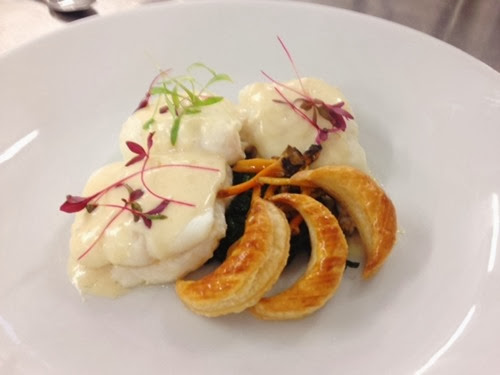 We cover so much in a single week at Leiths and get feedback on every aspect of every dish, so it can be hard to see the bigger picture and get a bit of perspective. Sometimes it’s difficult to feel like I’ve progressed at all but the dish above – sole bonne femme with chanterelles, pastry fleurons, spinach and microherbs – showed me that perhaps I have achieved something in my four months at cookery school after all! I know there’s no way I would have been able to make anything like this back in October and whilst (of course) there were aspects that could have been better it was still immensely satisfying to make this dish! Bring on week 6.
We cover so much in a single week at Leiths and get feedback on every aspect of every dish, so it can be hard to see the bigger picture and get a bit of perspective. Sometimes it’s difficult to feel like I’ve progressed at all but the dish above – sole bonne femme with chanterelles, pastry fleurons, spinach and microherbs – showed me that perhaps I have achieved something in my four months at cookery school after all! I know there’s no way I would have been able to make anything like this back in October and whilst (of course) there were aspects that could have been better it was still immensely satisfying to make this dish! Bring on week 6.
Sunday 16 February 2014
Leiths: Intermediate Term, Week 4
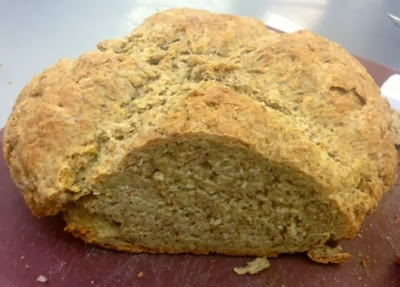 We started off the week with baking (yay) and soda bread, which I love to make because having a loaf of bread in under an hour from start to finish is so satisfying. This was to accompany our chicken liver pate, which to be honest didn’t exactly tempt me when I was prepping and frying the livers, but the end result was delicious and showed me that pate is actually much simpler and faster to make than I imagined. The session was followed by a demonstration on truffles (the underground kind, not the chocolate kind) by guest speaker Jorge Sancho. I knew next to nothing about the subject which was highlighted when Jorge stated that white truffle prices started at about ‘£3’ which sounded like an incredible deal until he clarified… ‘£3 per g, £3000 per kilo’ and any dreams of truffle cooking I may have had were instantly dashed!
We started off the week with baking (yay) and soda bread, which I love to make because having a loaf of bread in under an hour from start to finish is so satisfying. This was to accompany our chicken liver pate, which to be honest didn’t exactly tempt me when I was prepping and frying the livers, but the end result was delicious and showed me that pate is actually much simpler and faster to make than I imagined. The session was followed by a demonstration on truffles (the underground kind, not the chocolate kind) by guest speaker Jorge Sancho. I knew next to nothing about the subject which was highlighted when Jorge stated that white truffle prices started at about ‘£3’ which sounded like an incredible deal until he clarified… ‘£3 per g, £3000 per kilo’ and any dreams of truffle cooking I may have had were instantly dashed! 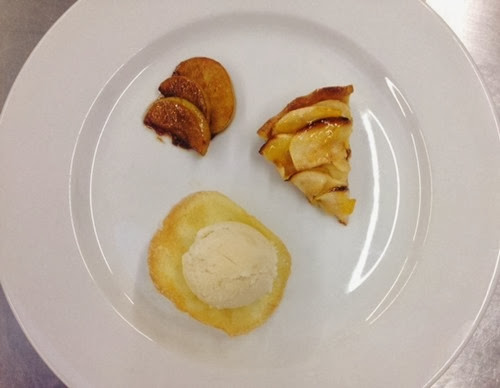 So far on the course our desserts have focused on serving up one element – a lemon meringue pie, a treacle tart or a cake etc. That changed this week as we spent 2 days bringing different elements together to create our apple dessert plate consisting of an apple tart, apple sorbet, caramelised apples and vanilla tuile. It was really satisfying to bring everything together and I found rapidly melting sorbet and pastry way less stressful to deal with than savoury plates where I’m balancing rapidly reducing sauces and meat cooking! The sorbet in particular was delicious and easier than I imagined and as I didn’t manage to bring it home I’ll definitely be experimenting with more sorbet flavours… once the weather in London gets a little less Arctic.
So far on the course our desserts have focused on serving up one element – a lemon meringue pie, a treacle tart or a cake etc. That changed this week as we spent 2 days bringing different elements together to create our apple dessert plate consisting of an apple tart, apple sorbet, caramelised apples and vanilla tuile. It was really satisfying to bring everything together and I found rapidly melting sorbet and pastry way less stressful to deal with than savoury plates where I’m balancing rapidly reducing sauces and meat cooking! The sorbet in particular was delicious and easier than I imagined and as I didn’t manage to bring it home I’ll definitely be experimenting with more sorbet flavours… once the weather in London gets a little less Arctic. 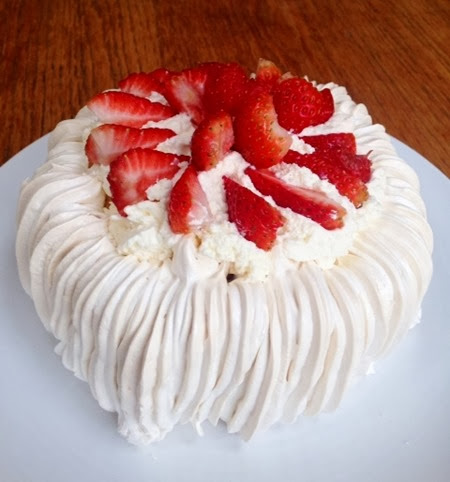 We ended the week on a delightfully retro note with a Strawberry Meringue Basket, aka a next level pavlova. The basket consists of a piped base and 3 meringue hoops all glued together with more meringue, which is then covered in more piping and filled to the brim with cream to hide all the construction work underneath. The main lesson I learnt making this was that piping is not my forte and definitely a skill that benefits from a lot of practice. The way I hold a piping bag is wrong and learning the new way by adjusting my hand position to actually make piping a lot easier initially felt super unnatural and required a lot of concentration! The trick is to apply all the pressure on the piping bag with your top hand, not the bottom hand which should only be a guide. I kept thinking I was doing it right, only for my teacher to point out he could see my fingerprints on the bag from where I had been squeezing with my lower hand. They don’t miss a trick! I shall definitely be practising piping with anything I can – be it mash, meringue, chocolate or icing, until I have it mastered. Bring on Week 5!
We ended the week on a delightfully retro note with a Strawberry Meringue Basket, aka a next level pavlova. The basket consists of a piped base and 3 meringue hoops all glued together with more meringue, which is then covered in more piping and filled to the brim with cream to hide all the construction work underneath. The main lesson I learnt making this was that piping is not my forte and definitely a skill that benefits from a lot of practice. The way I hold a piping bag is wrong and learning the new way by adjusting my hand position to actually make piping a lot easier initially felt super unnatural and required a lot of concentration! The trick is to apply all the pressure on the piping bag with your top hand, not the bottom hand which should only be a guide. I kept thinking I was doing it right, only for my teacher to point out he could see my fingerprints on the bag from where I had been squeezing with my lower hand. They don’t miss a trick! I shall definitely be practising piping with anything I can – be it mash, meringue, chocolate or icing, until I have it mastered. Bring on Week 5!
Wednesday 5 February 2014
French Onion Puffs
Puff pastry is one of those ingredients that I never manage to use up all at once. There is always a little bit at the end of the packet, tucked up and put back in the fridge…and then normally forgotten about until it’s too late. Leftover carrots, the end of a mozzarella ball and spare egg whites also fall into this category. Well, I’m still working on being better with those last three but I can safely say there will be no more sad bits of puff pastry languishing in my fridge in the future!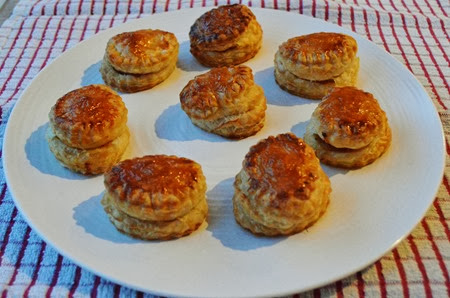 I used the end of the flaky pastry I had made at school to make these – after spending 2 days making it from scratch there was no way this was ending up in the bin. I’d seen the original French Onion Puff recipe on Joy the Baker and knew it sounded good, but I felt a bit decadent buying and using a whole packet just for little canapés. I’m so glad I got round to trying them because the recipe did not let me down. Crispy pastry filled with sweet caramelised onions and melting cheese – a few of these still warm from the oven alongside some salad made the perfect lunch. And the rest made perfect afternoon snacks…
I used the end of the flaky pastry I had made at school to make these – after spending 2 days making it from scratch there was no way this was ending up in the bin. I’d seen the original French Onion Puff recipe on Joy the Baker and knew it sounded good, but I felt a bit decadent buying and using a whole packet just for little canapés. I’m so glad I got round to trying them because the recipe did not let me down. Crispy pastry filled with sweet caramelised onions and melting cheese – a few of these still warm from the oven alongside some salad made the perfect lunch. And the rest made perfect afternoon snacks…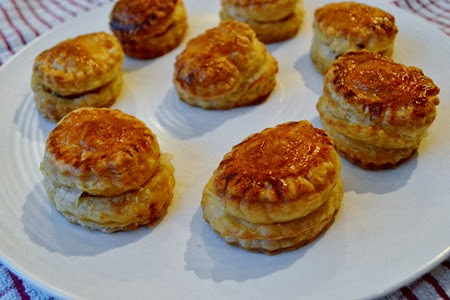 I followed the recipe fairly loosely, halving it to suit my smidge of pastry (I still got 10 little puffs) and using half a mug of vegetable stock instead of wine, but to be honest I think it’s easily adaptable to any quantity of ingredients you have. These would make a very popular canapé as you could make them ahead easily and just bake them off at the last minute – just be warned you may need to make a few more than you need as they are very addictive! You can find the recipe here – enjoy.
I followed the recipe fairly loosely, halving it to suit my smidge of pastry (I still got 10 little puffs) and using half a mug of vegetable stock instead of wine, but to be honest I think it’s easily adaptable to any quantity of ingredients you have. These would make a very popular canapé as you could make them ahead easily and just bake them off at the last minute – just be warned you may need to make a few more than you need as they are very addictive! You can find the recipe here – enjoy. 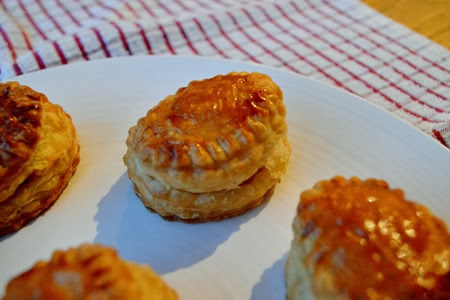
Sunday 2 February 2014
Leiths: Intermediate Term, Week 3
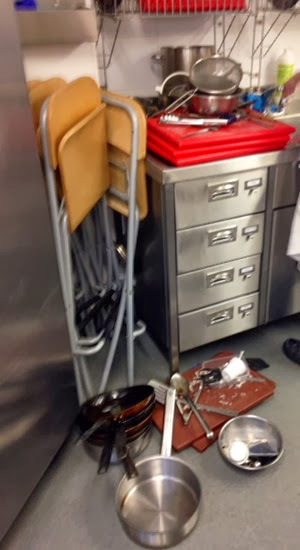 A lot of cooking = a lot of dirty dishes. Never was this more evident than on Wednesday, or ‘The Day The Washing Up Tried To Take Over’ as it shall be remembered. Who knew a bit of soup and pan fried fish could use so many pans?! Washing up piles on the floor is a new extreme and only strong teamwork + slight deliriousness managed to get us through. Fingers crossed my teacher isn’t reading this…we promise it will never happen again!
A lot of cooking = a lot of dirty dishes. Never was this more evident than on Wednesday, or ‘The Day The Washing Up Tried To Take Over’ as it shall be remembered. Who knew a bit of soup and pan fried fish could use so many pans?! Washing up piles on the floor is a new extreme and only strong teamwork + slight deliriousness managed to get us through. Fingers crossed my teacher isn’t reading this…we promise it will never happen again! 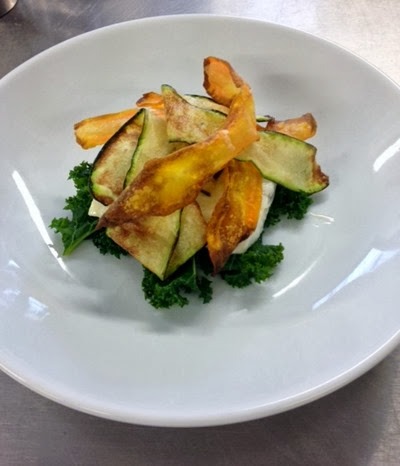 I’ve spoken several times about my newly discovered love of deep frying at Leiths. This was the week I found something I did not like to deep fry! Leeks. I know, not a classically deep fried ingredient but they were one of the vegetable ribbons on the menu on Friday and so in to the sizzling hot oil they went. And out they came…slightly blackened but still soggy. Mmmm. Happily the carrot ribbons made up for this. They were so good I think they were better than the treacle sponge we made on the same day. Sweet, crisp, salty – incredible. The only downside was once again smelling like a fish and chip shop for the remainder of the day.
I’ve spoken several times about my newly discovered love of deep frying at Leiths. This was the week I found something I did not like to deep fry! Leeks. I know, not a classically deep fried ingredient but they were one of the vegetable ribbons on the menu on Friday and so in to the sizzling hot oil they went. And out they came…slightly blackened but still soggy. Mmmm. Happily the carrot ribbons made up for this. They were so good I think they were better than the treacle sponge we made on the same day. Sweet, crisp, salty – incredible. The only downside was once again smelling like a fish and chip shop for the remainder of the day.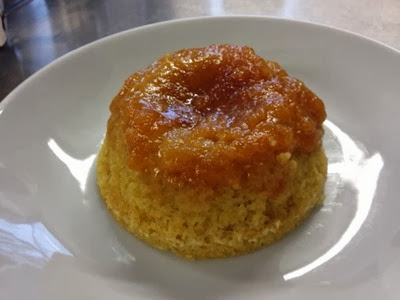 Friday was a day we had all been looking forward to: treacle sponge making! We had eaten it the day before in the demonstration and were looking forward to a lunch of kings to reward hours of steaming, fiddly basin prep and constant pan watching. Sadly, this was not quite the case. See there are two main ways to tell whether a steamed sponge is cooked at Leiths. 1 – insert a skewer into the sponge, pull out, if it has no crumbs clinging to it then you are ready to serve. 2 – insert a skewer, hold for 10 seconds, pull out and only if it is searingly hot when tapped on your wrist then is it cooked. Unsurprisingly, we pretty much all opted for method 1 and happily judged our puddings to be perfect. Sadly we failed to factor in the fact that when you pull out a skewer from a sponge covered in several layers of foil and paper, these will act as a barrier to any raw mixture clinging to your skewer and effectively clean the skewer before you see it. Cue many sadly flopping and sinking, slightly raw treacle sponges being turned out, just like mine above. It was still delicious, cooked on the outside (my family and I ate it all) but I’ll definitely be braver and do the second testing method next time!
Friday was a day we had all been looking forward to: treacle sponge making! We had eaten it the day before in the demonstration and were looking forward to a lunch of kings to reward hours of steaming, fiddly basin prep and constant pan watching. Sadly, this was not quite the case. See there are two main ways to tell whether a steamed sponge is cooked at Leiths. 1 – insert a skewer into the sponge, pull out, if it has no crumbs clinging to it then you are ready to serve. 2 – insert a skewer, hold for 10 seconds, pull out and only if it is searingly hot when tapped on your wrist then is it cooked. Unsurprisingly, we pretty much all opted for method 1 and happily judged our puddings to be perfect. Sadly we failed to factor in the fact that when you pull out a skewer from a sponge covered in several layers of foil and paper, these will act as a barrier to any raw mixture clinging to your skewer and effectively clean the skewer before you see it. Cue many sadly flopping and sinking, slightly raw treacle sponges being turned out, just like mine above. It was still delicious, cooked on the outside (my family and I ate it all) but I’ll definitely be braver and do the second testing method next time!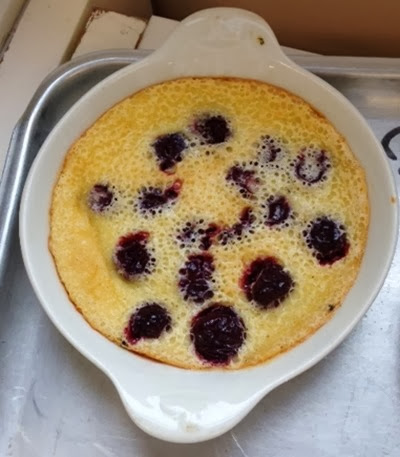 Cherry Clafoutis – using a crème anglaise base without the hassle! After 12 weeks at cookery school you might think we’re beginning to flit round the kitchen, whipping up delicious dishes in a breeze with a smile and a bow. Maybe one day but right now there is one nemesis that continues to strike fear through our wooden spoons every time it appears on the curriculum. Crème anglaise. Milk, egg yolks, sugar and a dash of vanilla conspire against us to either scramble instantly or stay resolutely runny. We’ve all made it perfectly before but this Thursday it just wasn’t happening. Between the 16 of us our class must have made at least 30 attempts and we were only allowed to stop as threats of crème anglaise hitting the wall started to be vocalised. I’ll get there…I just might be eating my crumble with ice cream instead for a while. Bring on the glamour of week 4!
Cherry Clafoutis – using a crème anglaise base without the hassle! After 12 weeks at cookery school you might think we’re beginning to flit round the kitchen, whipping up delicious dishes in a breeze with a smile and a bow. Maybe one day but right now there is one nemesis that continues to strike fear through our wooden spoons every time it appears on the curriculum. Crème anglaise. Milk, egg yolks, sugar and a dash of vanilla conspire against us to either scramble instantly or stay resolutely runny. We’ve all made it perfectly before but this Thursday it just wasn’t happening. Between the 16 of us our class must have made at least 30 attempts and we were only allowed to stop as threats of crème anglaise hitting the wall started to be vocalised. I’ll get there…I just might be eating my crumble with ice cream instead for a while. Bring on the glamour of week 4!